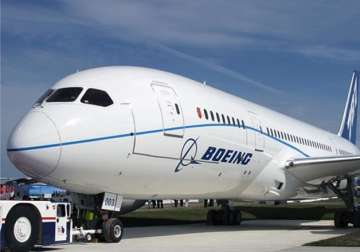Boeing says domestic airlines on way to break-even
Mumbai: Planemaker Boeing Corporation today expressed hope that domestic airlines, which have been bleeding for many years now, are moving closer to break-even as operating costs have fallen faster than fare reductions following the sharp

Mumbai: Planemaker Boeing Corporation today expressed hope that domestic airlines, which have been bleeding for many years now, are moving closer to break-even as operating costs have fallen faster than fare reductions following the sharp dip in oil prices.
"I believe that Indian airlines are moving closer to profitability after years of losses. Spicejet has declared profits in the June quarter after many years of losses. I hope Jet Airways also reports some good numbers tomorrow. IndiGo has been in profit for many years," Boeing senior vice-president for sales in Asia-Pacific & India (commercial airplanes) Dinesh A Keskar told reporters here.
Boeing's main customers in the country include Air India, Jet Airways and Spicejet which also have Airbus planes, while the largest carrier Indigo has only Airbus aircraft.
Others like GoAir has a mix of planes from both the planemakers.
Similarly, the new kid on the block Vistara also flies Airbus as Boeing could not meet its demand on a short notice, according to Keskar.
Citing a study carried out by Boeing, Keskar said the difference between the average fare and the average break-even fare for a Mumbai-Delhi flight was at Rs 1,221 in May 2014 but this has come down to just Rs 395 by May 2015-a nearly 68 per cent reduction in losses.
The reason behind this sharp fall is a 24 per cent decline in total operating costs while average fares have fallen by just 13 per cent, he explained, and argued that operating costs could have come down further but for the high level of taxes imposed on jet fuel, which varies from 4 per cent to 32 per cent in some states like Maharashtra.
He also said a stable rupee will help further cost reductions, even though the comment ironically came on a day when the rupee sniffed at 65 to the dollar, which is two-year low.
But to be fair, the rupee has been fairly stable all these years after the run on began in mid-May 2013 when the US Fed's taper lift-off began and is still one of the best performing major currencies.
Releasing the study in Mumbai, Boeing said while local airlines are continuing to lose money, break-even is within sight in the domestic market.
"Fuel prices have now come down by 33 per cent from their October 2013 peak, but yet the domestic airlines pay up to 50-60 per cent more for fuel than the airlines in the US," said Keskar.
On an average fuel constitutes 45-55 per cent of operational cost of a domestic airline and a 4 per cent reduction in it can potentially add around 2 per cent to the operating margin.
According to aviation consultancy firm Capa India, the domestic airlines have lost over USD 10 billion since fiscal year 2009 and their combined debt stands at around USD 11.3 billion now, and if the liabilities to the vendors are included the total debt burden is close to USD14 billion. At an industry level, airlines' debt is now equivalent to over 100 per cent of their combined revenue.
Sounding bullish on the domestic aviation sector and its prospects, Keskar said Boeing expects a demand for 1,740 new planes in the country by 2035, as it anticipates that more and more people will fly with rising incomes coupled with the overall economic prosperity.
According to Keskar, these orders would come for price tag of USD 240 billion.
Globally, Boeing expects the demand for new planes to grow by a whopping 38,050 over the next 20 years and India will account for 4.5 per cent of this.
When asked about his outlook for the air cargo segment, he said these 1740 new planes are only for passenger and private jets as he does not see a pure-play air cargo market developing in the country.
"I don't see a standalone air cargo market here. One of the main reasons is airplane makers like us are adding more cargo capacity in each of our new planes which on an average is 20 tonnes now," Keskar said.
In its annual current market outlook, Boeing raised its prediction for aircraft demand by 8.75 per cent compared to the 2014 forecast.
In March 2014, Boeing had said domestic airlines would need 1,600 new planes, valued at USD 205 billion, over the next 20 years.
Currently, domestic airlines together have around 400 operational planes and about 500 on order.
On the domestic passenger traffic, Keskar said it is at the highest levels now with over 66.4 million domestic passengers flying in 2014.
"We are expecting 75 million passengers flying this financial year," he added.